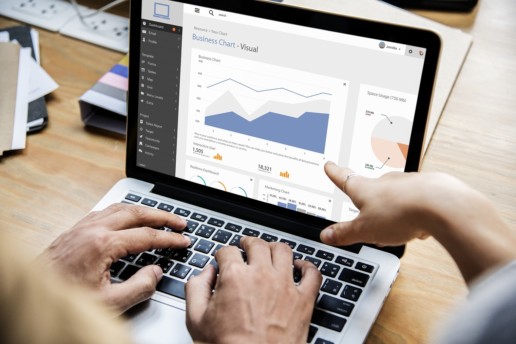Employers should ‘double down’ on tech and benefits data analytics. Most still aren’t
Did you know: 53 percent of benefits leaders say the biggest challenge they face regarding effective benefits programs is gaining access to their data. Read this blog to learn why employers should 'double down' on technology.
Utilizing data to understand which health benefits will best work for employees is key to staying ahead of the curve, but just 18% of benefits managers believe their organization has the right tools to implement these programs.
That’s according to a new survey by Artemis Health, which found that while 88% of benefits leaders say data is somewhat to extremely important in designing and managing an effective benefits program, some 53% percent say access to data is their biggest challenge.
“Benefits analytics is the key to feeling confident in building better benefits programs for their organizations and their employees,” says Grant Gordon, CEO and co-founder of Artemis Health.
Obtaining this data is often the biggest challenge to understanding what companies should be offering and if it’s in line with the demands of their workforce, the survey found.
“When you look at data, you can make a hypothesis about what you should do, and if it's working, you double down. If it's not working, then you change tactics,” Gordon says. “But because data is so hard to get here, many benefit leaders don't have that reflex or muscle memory.”
Gordon spoke with Employee Benefit News about the role of data analytics in benefits planning and how companies can best utilize these tools.
Why is data such a critical part of benefits planning?
The top cited source of information that benefits leaders are relying on to define their benefits is employee feedback, and you absolutely have to have that. But if you take a step back from that, the role that I view data having is an objective way to look at what's actually happening with your employees and understand what the big strategic issues are. You may miss a silent group of people who really need help or an emerging trend that you need to address that you could have caught with data.
Most employers said that they didn't have the proper tools to use data effectively. Why do you think that is?
Just getting your hands on the data is a big challenge. You have to go the vendors that hold it, you have to give them assurances and sign legal documentation that you're going to use it appropriately and that you’ll keep it private, and that can take a long time. And then once you get the data, there's no really good data infrastructure in this industry to share data securely. So there's some orchestration challenges in shipping data around. You might get wrong data or you might get incomplete data. And then once you get it, it can be full of errors that need to be corrected. So before you even get to the starting gate, there's a big challenge.
Then you get to the next problem, which is that the data is very complex, and there's a lot of subject matter expertise that you need to have to understand it. And so in order to make this useful to a benefits person who's maybe not a deep, deep expert on medical, clinical knowledge or pharmaceuticals or certain programs, you need to simplify it so they can get to the trends. We can’t expect them to look at raw claims data and make anything of it. There’s a tooling challenge in getting the data and really making sense of it.
How can benefits managers bridge that knowledge gap?
Make sure that people get the healthcare and the benefits that they need. We saw [in the survey] that if they had more confidence in the moves that they were making, perhaps with data, they could get more things that are relevant to their employees into their hands faster, but it's just not the case today. So something needs to be addressed.
Get a data platform. I think some of the players that have been around for awhile, they do a fantastic job at data management and all those other things. I would look at something like Artemis or one of the newer companies, just to get a jumpstart on data-driven decisions on what's important and what's working and what's not. A lot of these companies work with advisers like consultants or brokers and many of them have inner resources internally. There are people who know the data really well who can really help you get more value out of that. So I would encourage them to make sure that they're asking specifically about getting data support from some of those advisers.
What does the future look like when it comes to utilizing technology and data in the benefit space?
If you look at other departments like marketing or finance or sales, they're all using data as a matter of course. It's a fabric that they weave the rest of what they do. The future of data here is making it easy for benefit leaders to understand all of those things and how to do those things and do them every day. When you're deciding what your major strategic initiatives should be for the year, being able to have that on tap in the data and actually being able to rely on that, and once you roll out a program or make a benefit change, measuring the impact of that.
SOURCE: Place, A. (12 December 2019) "Employers should ‘double down’ on tech and benefits data analytics. Most still aren’t" (Web Blog Post). Retrieved from https://www.employeebenefitadviser.com/news/employers-should-double-down-on-tech-and-benefits-data-analytics-most-still-arent
New analytics tool helps employers dig deep into turnover trends
A new analytics tool aims to help employers troubleshoot what might be causing issues with your hiring and talent retention. Continue reading this blog post to learn more.
One HR software provider is aiming to help employers better understand why workers fly the coop.
Namely has added a machine learning and data analytics product to its suite of offerings for HR departments, the company said Wednesday. Its tool, dubbed Benchmarking Package, allows HR teams at midsize employers to take a deeper dive into what might be causing issues with a company’s hiring and talent retention.
The machine learning technology distills company turnover data and compares it to information from similar employers in the system, says Eric Knudsen, manager of people analytics at Namely. The comparison data is taken from the more than 1,000 employers and 175,000 employees using Namely’s platform.
“Midsize companies who have historically lacked the skills to uncover these insights are getting a new view on the workplace that they’re building,” he says.
The turnover data is anonymous.
Reviewing termination data can give employers insight into the types of employees who are leaving and potentially lead to broader insights on workplace diversity. It also can help employers better understand how they stack up against the competition and whether the company has a healthy turnover rate, Namely says.
Lorna Hagen, chief people officer at Namely, says information like this can help employers get a sense of issues that may arise in the future.
“If I’m seeing pockets of people come from a certain area of work background with higher levels of attrition, what does that mean to my recruiting strategy; what does that mean to my product strategy? It impacts how you think about your company’s future,” she says.
HR departments are placing a higher value on data analytics, and HCM software developers are taking note. For example, Paychex recently added a data analytics feature to Paychex Flex, its HCM and payroll administration platform. The feature also provides users with data on hiring and turnover trends, and companies can anonymously compare data with similar employers.
During beta testing of Namely’s benchmarking product, Knudsen says the company was able to identify certain trends by looking at employer data. In particular, he says, Namely found a notable uptick in job abandonment, or ghosting. The rates of abandonment were higher for companies in the retail and real estate industries, he says, and lower for those in the non-profit sector. The company also found that managers with eight or more direct reports had higher rates of turnover.
Hagen says that employers who look at granular data are better able to understand why workers are leaving, which can help them take steps to reduce turnover immediately.
“It’s a much more interesting conversation, quantifying what is happening with your people,” she says. “The rolling 12 month turnover rate is an interesting metric but it’s not actionable. The ability to look by level or by department — those are ways to start thinking about action.”
Namely says the benchmarking package is available to all current clients, including identity access management provider OneLogin, retailer Life is Good, financial services company The Motley Fool and recruiter software company JazzHR. The price of the product varies based on company size, but typically varies per employee per month.
SOURCE: Hroncich, C. (16 January 2019) "New analytics tool helps employers dig deep into turnover trends" (Web Blog Post). Retrieved from https://www.benefitnews.com/news/new-analytics-tool-helps-employers-dig-deep-into-turnover-trends?feed=00000152-a2fb-d118-ab57-b3ff6e310000
Analytics are key to wellness success. Here’s why
How can benefits managers utilize analytics to maximize their companies’ investments? Continue reading to learn how analytics can help employers optimize their health, wellness and other benefits programs.
What do benefits managers have in common with Walmart? Both have the power to leverage data to create a sustainable competitive advantage.
Like other leading retailers, Walmart mines vast quantities of data and applies predictive analytics to fuel solutions that improve store checkout processes, maximize inventory turnover and optimize product placement. Data analytics also helps the company identify shoppers’ preferences and personalize their shopping experiences. New parents, as identified by prior purchases, might receive digital coupons for infant products, for instance.
Walmart’s data intelligence gives the international retailer the ability to act upon insights quickly. One Halloween, for example, a novelty cookie generated high sales across the United States, but no sales at all in two U.S. stores. The company’s data analytics swiftly ascertained that the cookies were never put on the shelves at those stores. The problem was resolved immediately through high-visibility product placement.
Employee benefits managers have similar opportunities to maximize their companies’ investments. The effective use of disparate data can help employers optimize their health, wellness and other benefits programs, and pinpoint the true value of their total rewards.
A data-driven approach to benefits analytics
Three out of five U.S. employers use health screenings and risk assessments to help employees detect conditions earlier, when treatment might be more effective and costs lower. However, the majority of employers do not measure the impact of these programs.
Those that do assess a program’s impact typically compare the dollars spent on it with the medical claims saved. Forward-thinking benefits managers, however, are examining the total value of investment (VOI) instead. This innovative approach analyzes not only the effect of a wellness initiative on medical costs but also its influence on productivity, absenteeism, disability costs and other factors.
By aggregating and analyzing different types of data — such as claims and non-claims data — benefits managers can determine crucial correlations between preventive screenings, health outcomes and healthcare costs. Thus, they can develop more targeted benefits packages that reduce costs while improving overall employee health and productivity.
Case Study: Implementation of predictive analytics in preventative screenings
One recent initiative undertaken by a state employee health plan demonstrates the power of data analytics to reveal the VOI of preventive cancer screenings.
The state provides medical benefits to around 205,000 employees and dependents. The agency that administers the benefits program wanted to know whether preventive cancer screenings improved health outcomes, and whether the program was cost effective. Analyzing screening and claims data showed that 6% to 8% of those who underwent screenings for breast, colorectal or cervical cancer received a diagnosis of cancer or a related condition. The follow-up and all-important question was: did those members experience different outcomes than members whose cancers were not detected through screenings?
The results indicated a high VOI for members’ preventive cancer screenings:
- The majority of new cases of breast, colorectal and cervical cancer were detected through preventive screenings.
- Among members who received preventive screenings, 5% to 11% underwent treatments because of screening results — and not just for cancer. Treatments included removal of benign tumors or polyps.
- Those diagnosed with breast, colorectal or cervical cancer through the screenings experienced less invasive treatments and had fewer complications than those diagnosed through other means.
- New cases of breast and cervical cancer diagnosed through the preventive screenings had lower costs, on average, than cases detected through other means.
Positive action through data
This cancer screening example illustrates how data analysis can empower benefits managers to improve employees’ health outcomes while reducing costs. Analytics can help employers invest in more effective care management resources, as well as design benefits packages that provide positive VOI in wellness, screening and preventive care.
With the cost of health benefits continuing to rise, it’s critical to leverage data to determine the total value of wellness investments. Just as retailers use data analytics to improve the retail experience and increase profits, benefits managers should use data analytics to guide the design and evaluation of benefits and other rewards.
SOURCE: Kramer, M. (21 January 2019) "Analytics are key to wellness success. Here’s why" (Web Blog Post). Retrieved from https://www.benefitnews.com/opinion/analytics-are-key-to-wellness-success-heres-why
Creating Better Employee Benefits With Advanced Analytics
It is important to provide a workplace, employee benefits and payment system that keep your employees happy. Read this blog post to learn how you can create better employee benefits with advanced analytics.
Job satisfaction is the most important part of maintaining a happy workforce. If you have a workforce that feels like they could get a better deal elsewhere then they are likely to leave.
It is therefore important to provide a working environment, benefits and payment system, that keeps your employees happy without breaking the bank.
Analytics are being used to make sure that this is being done effectively, seeing where discontent is occurring and helping to suggest how this can be solved.
For instance, there are research companies that can use text analysis tools to analyze hundreds, if not thousands of survey entries that can give a holistic view of employee benefits. Often when survey results are being analyzed by an individual, it is difficult to gauge the overall feeling and there can be bias put on the results.
It also allows for HR to note the frequency of meetings with individuals as well as the frequency and size of any pay rises. If it is flagged that somebody hasn’t had a meeting with HR where they can directly communicate any concerns for a considerable amount of time, then tho scan be rectified.
Analytics can also be used to investigate which teams are happiest, have the highest retention rates or are the most profitable. This then allows companies to investigate in detail what is making these teams happiest or most productive, then create benefit packages to create similar results for other teams in the company.
Analytics and data have allowed companies to collect data to make their workforces happier and more content. This, in turn, creates situations where employees are eager to work and appreciative of the benefits they receive, improving ROI and increasing productivity.
SOURCE: Pannaman, E. (12 October 2018) "Creating Better Employee Benefits With Advanced Analytics" (Web Blog Post). Retrieved from https://channels.theinnovationenterprise.com/articles/202-creating-better-employee-benefits-with-advanced-analytics
Predictive Analytics Will Be The Silent Game-Changer In Employee Benefits
Employers can now use their own data to help fine-tune their employer-sponsored benefits packages. Continue reading to learn how this technology could be used to help fine-tune employee benefits offerings.
Last year’s World Series between the Houston Astros and the Los Angeles Dodgers came down to a seven-game battle based not only on talent, athleticism and coaching but also on data. Just as Sports Illustrated suggested back in 2014 via predictive data, the Astros were the victors.
The publication of Moneyball: The Art of Winning an Unfair Game spurred not only Major League Baseball teams to deploy predictive analytics, but also businesses to take a harder look at what their data means. It's no longer part of the hype cycle: Statista forecasts (paywall) that the predictive analytics market worldwide will reach $6.2 billion in 2018 and $10.95 billion in 2022.
I believe we are also at a transformational point in improving corporate employee benefits and our employees’ lives by embracing predictive analytics. HR is swimming in rich data. Instead of guesstimating needs across multiple generations of employees, employers can turn to their own data to fine-tune what they are offering as benefits solutions. Companies spend 25-40% of an employee’s salary on benefits. It simply makes strategic and financial sense to get it right.
Bring Employee Benefits Out Of The Dark Ages
Hiring and retaining great talent is at the very soul of almost every company’s strategy. Not surprisingly, more companies have turned to predictive analytics to give them a leg up in recruitment. However, HR benefits have lagged behind. As John Greenwood reported to Corporate Adviser, “More than half of reward and employee benefits professionals see predictive analytics as a game-changer, but 90 percent are still using spreadsheets to manage data, research from the Reward & Employee Benefits Association shows.”
One reason for benefits lagging behind recruitment in adopting predictive analytics is that the way companies choose new benefits varies greatly from business to business. Given that the majority of HR departments keep data in disparate spreadsheets, even if some HR departments conduct employee surveys or historical cost analyses, they often do not integrate the data about their workforce. If a new benefit offering is chosen based on a needs analysis, only some know the “why” behind a request from the workforce. Knowing how many employees are logging into a benefits platform is helpful; market standard benefit utilization reports provide this level of information. Yet they do not give insight into the underlying reason for an employee to utilize a benefit. The user of deeper analytics is required to look deeper into employees' behavior.
We have found firsthand that many HR departments do not have a full understanding of how their employees are utilizing their benefits across the entire offering suite. A one-size-fits-all or a one-off strategy no longer is effective. Companies must understand not only their employees’ needs but also the underlying data related to these needs to provide a valuable benefits offering.
Put Your Existing Data To Use
For the past five years, I have watched our clients glean valuable insights into what the real underlying issues are for their employees and what must be done to address these pressing needs. I also have been watching companies realize that what they thought were the core problems at hand sometimes were not.
For example, one of our national high-tech clients, with over 50,000 benefit-eligible employees, believed that a high number of their employees had children struggling with autism. This belief was initially based on input from some of their employees. After approximately 16 months, the client reviewed the masked utilization data from their benefit platform. The data illustrated that the overwhelming majority of employee families (tenfold) in fact faced challenges associated with youth anxiety, a concern that had never been expressed to HR previously. Once they reviewed what employees were doing within our platform, their results mirrored the National Institute of Mental Health’s report that approximately 31.9% of U.S. children ages 13-18 struggle with anxiety disorders.
Their own data helped them understand much more specifically where their employees’ stress lay, and their HR department was able to focus communications around it.
Getting Started
Mining and viewing use data across all benefits is ideal. This enables an employer to determine if the benefit suite is serving employees effectively. We have found that as quickly as year over year, users' behaviors shift. If a company solely chooses a benefit based on what they saw as most heavily utilized the previous year, they are not being strategic.
For that reason, HR should utilize past and current data to better predict future patterns of need for a truly strategic approach to benefit choice. With this insight, they can make better choices and serve their workforce more effectively.
Given the limitations across many employee benefit vendors today, to start initially:
1. Embrace KPIs. Agree upon them internally, and measure benefit vendors on them.
2. Work with your current vendors to determine what data they provide to support your internal analysis. Ensure you have access to all the data you need, and if not, consider a vendor change.
3. Hold possible new vendors to similar data standards, and create a transparent relationship from the start.
4. Collect current and historical data. Existing vendors can provide this history, so make sure to collect at least 2-3 years of information.
These analytics need to go deeper than basic demographics to show patterns of activity. In order to understand the benefit needs of your workforce, you'll want to analyze trends across multiple data sets: medical, pharmacy, worker's compensation, biometric screenings, utilization patterns, FMLA requests and demographic trends. From there, you can start to pinpoint what your employees need -- and the “whys” behind the needs -- in order to make a measurable impact.
While predictive analytics is still in the nascent phase in the benefits and vendor worlds, the easiest and most proactive thing any employer can do is to focus on other insights vendors can provide related to the workforce and benefit use beyond simple utilization. In doing so, you will be able to support your employees both in their work lives and their personal lives by providing them with the benefits they need to be at their best.
SOURCE: Goldberg, A. (2 October 2018) "Predictive Analytics Will Be The Silent Game-Changer In Employee Benefits" (Web Blog Post). Retrieved from: https://www.forbes.com/sites/forbestechcouncil/2018/10/02/predictive-analytics-will-be-the-silent-game-changer-in-employee-benefits/#26648166e182





